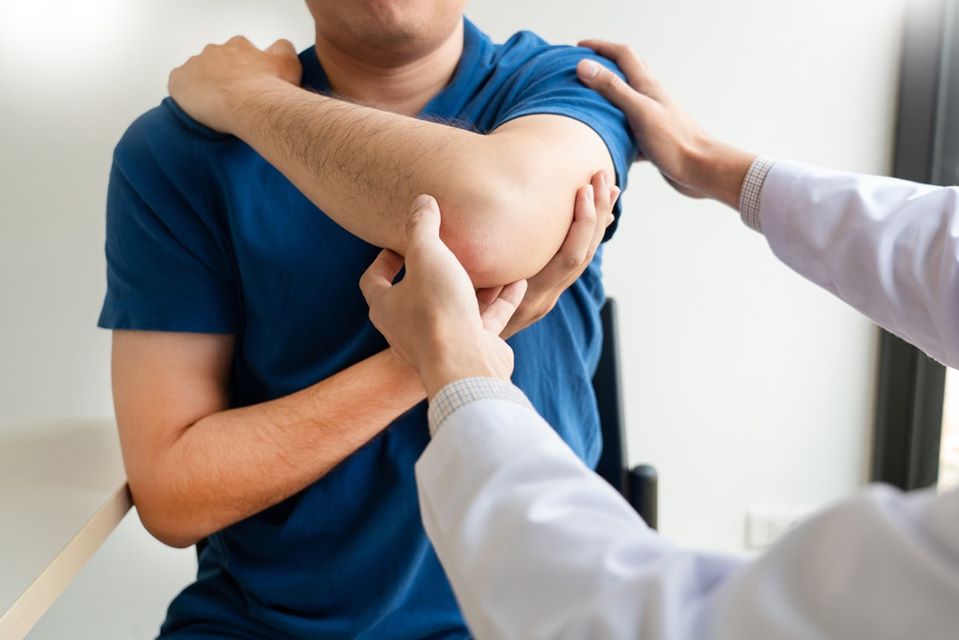Diagnosis and Treatment of Elbow Arthritis in Wake County

What is Elbow Arthritis?
Elbow arthritis occurs when the cartilage in the elbow becomes worn or damaged. The condition can develop from overuse due to age and repetitive activities, or as the result of an injury. For many people, arthritis of the elbow can cause pain not only when bending the elbow, but also when straightening it. If elbow pain is making it harder to do everyday activities, such as carrying groceries, arthritis is likely present.

What Causes Elbow Arthritis?
Rheumatoid Arthritis
Rheumatoid arthritis is the most common cause of elbow arthritis. It is a disease of the joint linings, or synovia. As the joint lining swells, the joint space narrows and gradually destroys the bones and soft tissues. RA usually affects both elbows, as well as other joints like the hands, wrist, and shoulder.
Osteoarthritis
Osteoarthritis is more common in weight-bearing joints such as the knees and hips, but it can also affect your elbows. It happens when you lose the cartilage that cushions the joints, causing the bones to rub together.
Post-Traumatic Arthritis
Post-traumatic arthritis is caused by an injury to the elbow joint, like a fracture or dislocation, and leads to progressive deterioration of the joint. Such injuries include fractures of the distal humerus, radial head fractures, and olecranon fractures.
Symptoms of Elbow Arthritis
Common symptoms of elbow arthritis may include:
- Pain
- Swelling
- Instability
- Grinding, popping, or cracking of the elbow joint
- Locking
- Stiffness or decreased range of motion
- Tingling
- Stiffness or decreased range of motion
How is Elbow Arthritis Diagnosed?
During a physical examination, your Raleigh Orthopaedic physician will first look for swelling, redness, and tenderness around the elbow joint. They will also assess your range of motion and identify what positions cause pain in your elbow. They may order imaging tests such as an X-ray to look for narrowing of the joint and any loose bodies (bony pieces). If your pain is due to arthritis following an injury, the X-ray may show an improper joining or failure to join the elbow bones.

Treatment For Elbow Arthritis
Treatment for elbow arthritis will depend on several factors, including the cause of your arthritis. In most cases, conservative treatments are helpful in decreasing pain and improving elbow function.
- Heat and ice: Heat can be helpful in loosening joints and relaxing stiff muscles, while ice is generally effective for flare-ups and swelling at the end of the day.
- Cut back on activity: Avoiding certain activities or sports, or having periods of rest after exercise involving your elbow, can relieve stress on the joint.
- Anti-inflammatory medications: Drugs such as ibuprofen and naproxen can be taken to reduce pain and swelling.
- Physical therapy: Rehabilitation exercises can help you avoid stress on your elbow and build strength and mobility.
You may be a candidate for elbow arthritis surgery if your elbow pain interferes with your daily life and conservative treatments do not provide relief. The specific type of surgery may depend on the type of arthritis that is present, the stage of your disease, your age, and your expectations. Discuss options with your Raleigh Orthopaedic surgeon to determine the best treatment path based on your condition.
Arthroscopy
Using a few small cuts around the elbow joint, your surgeon will insert thin instruments to remove pieces of bone, cartilage, or damaged tissue. Arthroscopic surgery allows for less pain and scarring and a faster recovery. This procedure can be used for both rheumatoid arthritis and osteoarthritis.
Synovectomy
During synovectomy, your surgeon will make a larger incision to remove bone spurs or damaged areas from the lining of the joint (synovium). This procedure is often used in the early stages of rheumatoid arthritis.
Arthroplasty
In severe cases, your surgeon may create an artificial joint using an internal prosthesis or external fixation device. Arthroplasty, or total joint replacement, is usually reserved for patients over 60 years old or patients with RA in advanced stages.

How Long Does Recovery Take After Surgery
Your recovery time following surgery for elbow arthritis will depend on the method of surgery you undergo. Recovery from elbow arthroscopy can take between six and eight weeks – this surgery involves the shortest recovery time due to its minimally invasive method. Recovery from elbow synovectomy can take six to twelve weeks, and full recovery from elbow arthroplasty can take up to a year.
Can I Prevent Elbow Arthritis from Developing?
The most common cause of elbow arthritis is overuse and repetitive movement. To prevent arthritis, it is important to avoid using repetitive motions that can add stress and tension to the elbow. If you work or play a sport where pressure is constantly being put on the elbow, taking breaks to stretch your arms frequently can reduce your risk of arthritis. Exercising before these activities as well as incorporating general workouts into your routine can also be extremely helpful in preventing arthritis.

Comprehensive Treatment for Elbow Arthritis at Raleigh Orthopaedic
Each of our Wake County clinics at Raleigh Orthopaedic offer care from elbow specialists who truly care about the needs of each patient. We will work with you to understand your symptoms and provide an effective treatment plan that addresses all of your needs, whether you are dealing with elbow arthritis or another orthopedic condition. To learn more about our services or to schedule an appointment, please contact us today. You can also easily book your appointment online!





